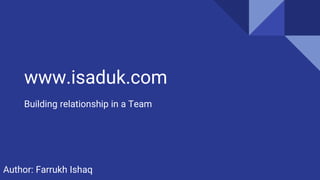
Learn what impact indivual have on Team dynamics
- 1. www.isaduk.com Building relationship in a Team Author: Farrukh Ishaq
- 2. What is Team Dynamics ● Learning; how the influences of every team member can decide the overall effectiveness of a team ● ‘They are like undercurrents in the sea,which can carry boats in a different direction to the one they intend to sail.’ Team Technology
- 3. How Team Dynamics arise Team Dynamics arise by: ● The nature of work. ● The personalities within the team. ● Working relationships. ● The work environment.
- 4. The Difference Between Team And Group Dynamics Team dynamics are very similar to Group dynamics, however the exact difference between the two is: ● Group Dynamics refer to small groups of people who share a common goal, however they may all work individually. ● Team Dynamics refer to how all members rely on each other for success and without every member of the team doing their part it can result in failure.
- 5. Psychological Models Of Team Dynamics There are many models used to describe team dynamics. Many of them describe the psychological aspects of group dynamics, such as: ● Team Roles. ● Personality type theories ● Team Islands and In/Out groups.
- 6. Non-Psychological Models Relevant To Team Dynamics In addition, there are many other models that have an important bearing on team dynamics and performance: ● Models of organisational culture ● Organisational structure ● Stakeholder models These have a hidden but significant impact on how a team interacts and functions.
- 7. Strategies To Improve Team Dynamics To improve team dynamics there needs to be a diagnosis to help identify the type of intervention that will have be successful. This is because teams have many factors that can affect the performance(e.g. Personalities and differences cultures). In the diagnosis stage the current team dynamics are investigated to identify the primary factors causing any problems or lack of team performance. From this diagnosis stage the next step is to conduct interviews with each member of the team to try and see what aspect is affecting the team's performance.
- 8. Intervention to help improve team dynamics There are many types of intervention that can affect team dynamics, some examples being: ● A change of organisational structure. ● Personality workshops. ● Stakeholder workshops. ● New processes, tools, or technology.
- 9. The necessity of hard and soft skills When working within a team, there is a necessity of having both hard and soft skills. Within a team there is more emphasis is on soft skills such as communication, Team working skills and the being willing to learn off of other team members. Hard skills are always useful within a field of work, however within a team these are downplayed in favour of having better communication.
Editor's Notes
- These factors can affect the inner working within teams for good or bad.
- Team Roles examining team performance is related to nine psychological roles taken by different team members. Personality type theories, consider how the different preferences of team members affect their interactions and team performance. Team Islands and In/Out groups, showing how sub-teams can form as a result of members having different characteristics or being separated by a geographical boundary.
- Stake Holder Models including governance structure, customer forums and feedback, representative groups (e.g. unions), etc. organisational culture considers five cultural factors: power distance, uncertainty avoidance, individualism/collectivism, Genders, Focus. organisational structure, including hierarchical, functional, matrix, network, cross-functional teams, working parties, etc.
- A change of organisational structure: reassignment of personnel, or change of office layout. Personality workshops that increase awareness of interpersonal skills. Stakeholder workshops, to give the team a wider perspective or understand others’ views of the team’s performance. New processes, tools, or technology to facilitate better communication.